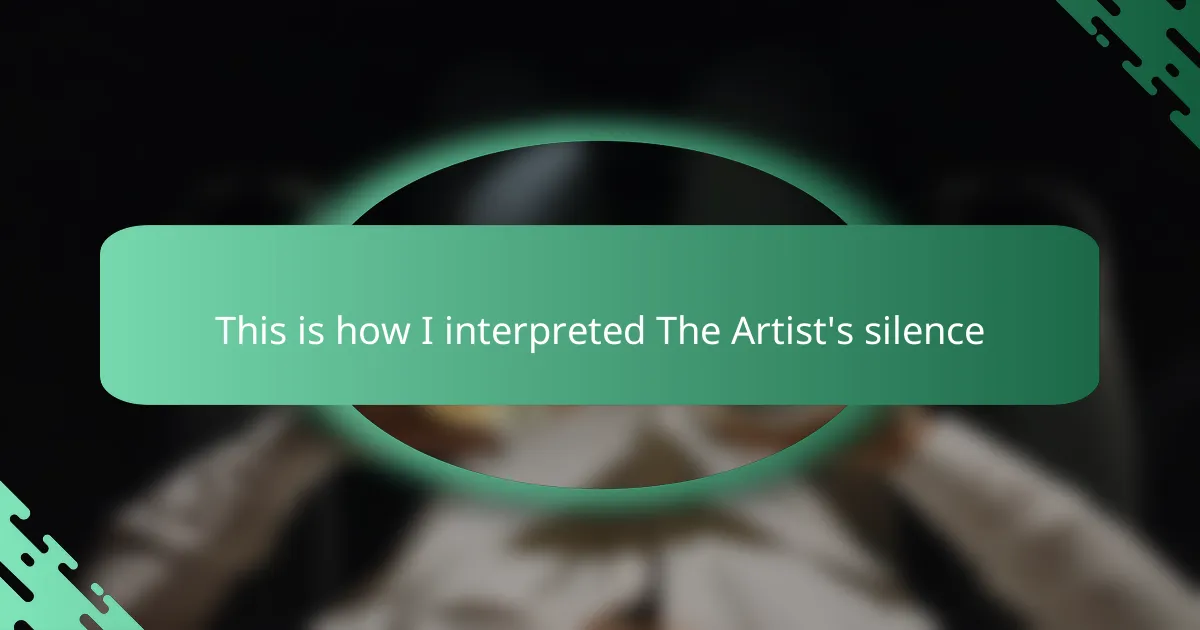Key takeaways
- French cinema showcases diverse styles, notably the French New Wave and poetic realism, reflecting cultural nuances and innovative storytelling.
- “The Artist” creatively pays homage to silent films while exploring themes of nostalgia, love, and the evolution of Hollywood.
- Silence in film enhances emotional depth, allowing for introspection and connection with characters through non-verbal communication.
- The film emphasizes the struggle between traditional and modern filmmaking, illustrating the impact of technological change on cinema and personal relationships.
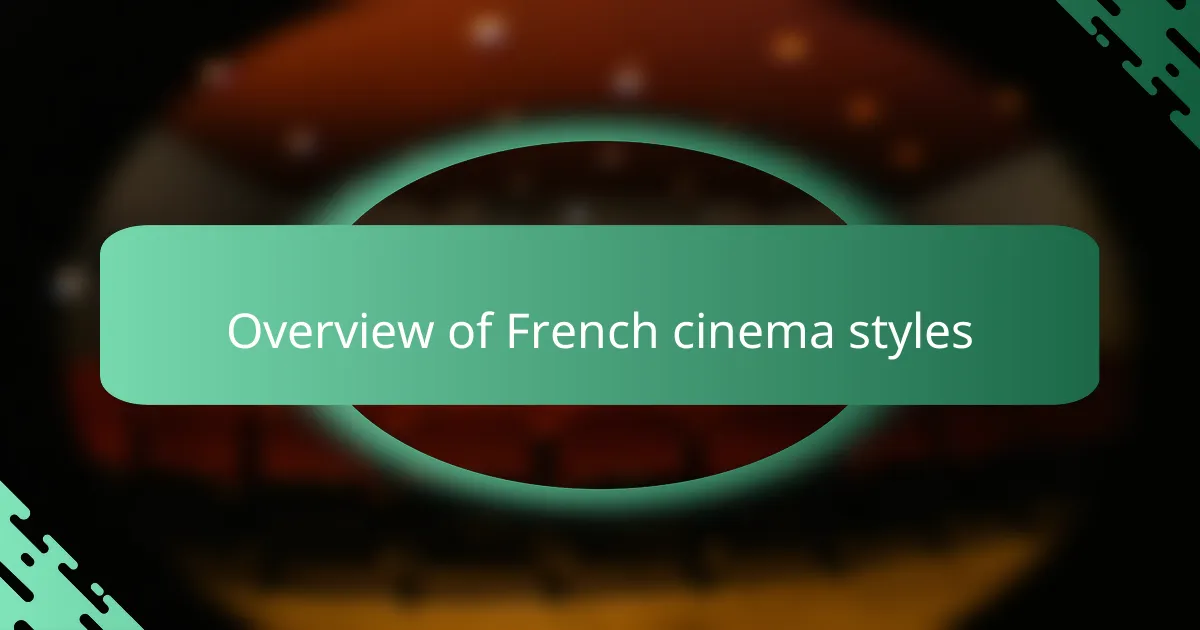
Overview of French cinema styles
French cinema is renowned for its artistic diversity, often characterized by distinct styles that reflect both cultural nuances and individual filmmaker visions. For instance, the French New Wave, emerging in the late 1950s, represents a groundbreaking movement where directors like Jean-Luc Godard and François Truffaut broke conventional storytelling molds. I often find myself captivated by the spontaneity and raw energy in these films; it’s as if they invite the audience into an intimate conversation rather than just presenting a narrative.
Another style worth noting is the poetic realism seen in films from the 1930s. This approach combines lyrical visuals with gritty social realism, evoking profound emotions and a sense of melancholy. I vividly recall watching “Le Quai des Brumes” and being struck by how beautifully the film paints the struggles of its characters through poetic dialogue and moody cinematography. Isn’t it fascinating how a film can encapsulate the essence of an entire era?
Finally, the contemporary French cinema landscape reflects an influential blend of genres, merging traditional storytelling with innovative aesthetics. Filmmakers today often draw from classic influences while pushing boundaries to explore modern societal themes. It’s exciting to see how these evolving styles resonate with audiences, making us ponder how cinema shapes our perceptions of reality. Have you ever wondered how much a film can alter our view of life itself?
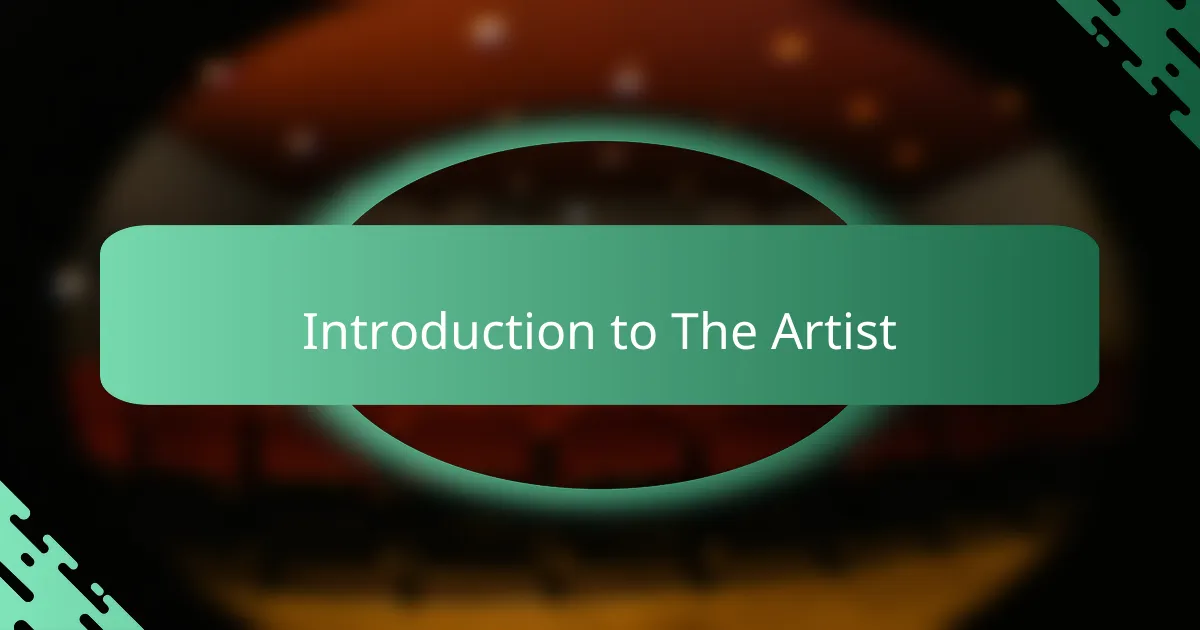
Introduction to The Artist
Set in the backdrop of Hollywood’s transition from silent films to talkies, “The Artist” brilliantly pays homage to the silent film era while infused with a modern sensibility. I recall the first time I watched it; the storytelling felt refreshingly vibrant despite the absence of spoken dialogue. It’s remarkable how the actors conveyed deep emotions and complex relationships purely through gestures and expression.
What struck me was the film’s ability to transport viewers to a different time and place, allowing us to revel in both nostalgia and innovation. The black-and-white cinematography, coupled with a charming musical score, created an atmosphere that was as enchanting as it was haunting. Have you ever felt transported by a film, where every frame seems to hold a deeper meaning?
Moreover, “The Artist” stands out not just for its artistic choice to remain silent, but for how it captures the insecurities and triumphs of its characters with such grace. I found myself rooting for George Valentin, the protagonist, as he navigated the turmoil of an industry in flux. His journey feels like a reflection of our own challenges—doesn’t it resonate with anyone who has faced uncertainty in their path?
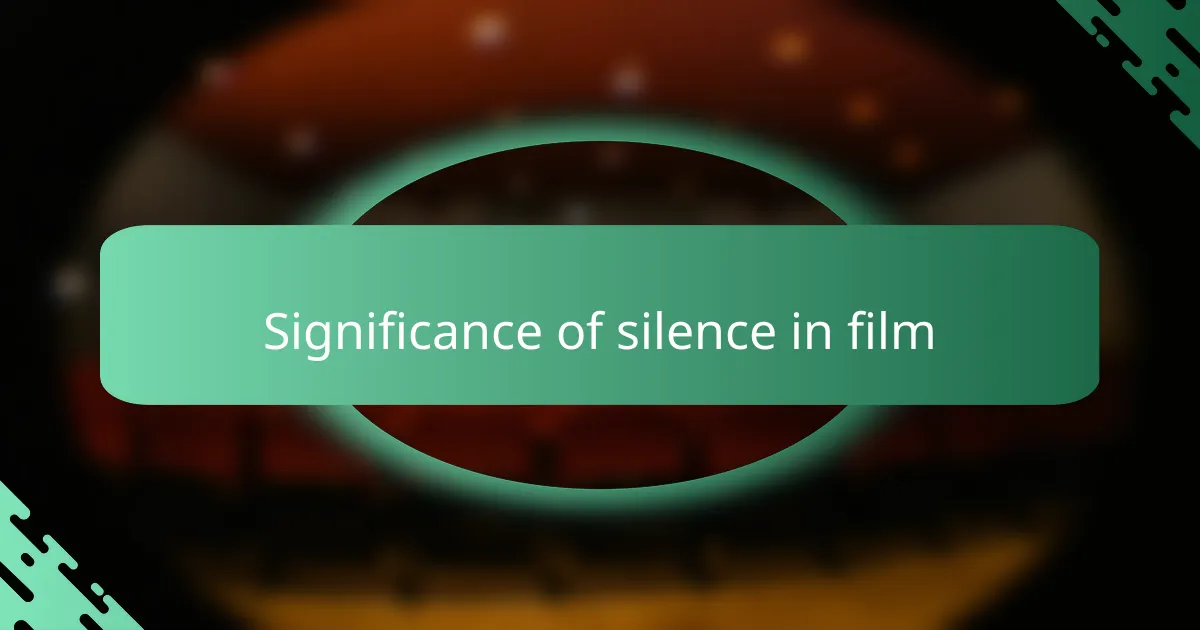
Significance of silence in film
Silence in film holds a profound significance that often transcends dialogue. I’ll never forget the first time I watched a movie that masterfully utilized silence; it felt like I could hear my own heartbeat. It was a breathtaking experience that made me appreciate how the absence of sound can evoke deep feelings and highlight critical moments in a narrative.
The use of silence often serves multiple purposes:
- It creates tension, making viewers lean in closer, eager to grasp what’s unsaid.
- It allows for introspection, encouraging the audience to reflect on what they just witnessed.
- It emphasizes emotions, giving weight to expressions and gestures that otherwise might go unnoticed.
- It can symbolize isolation or the weight of unsaid words, resonating deeply with personal experiences.
This interplay between silence and what it communicates often leaves a lasting impression, revealing layers in character development and thematic depth.
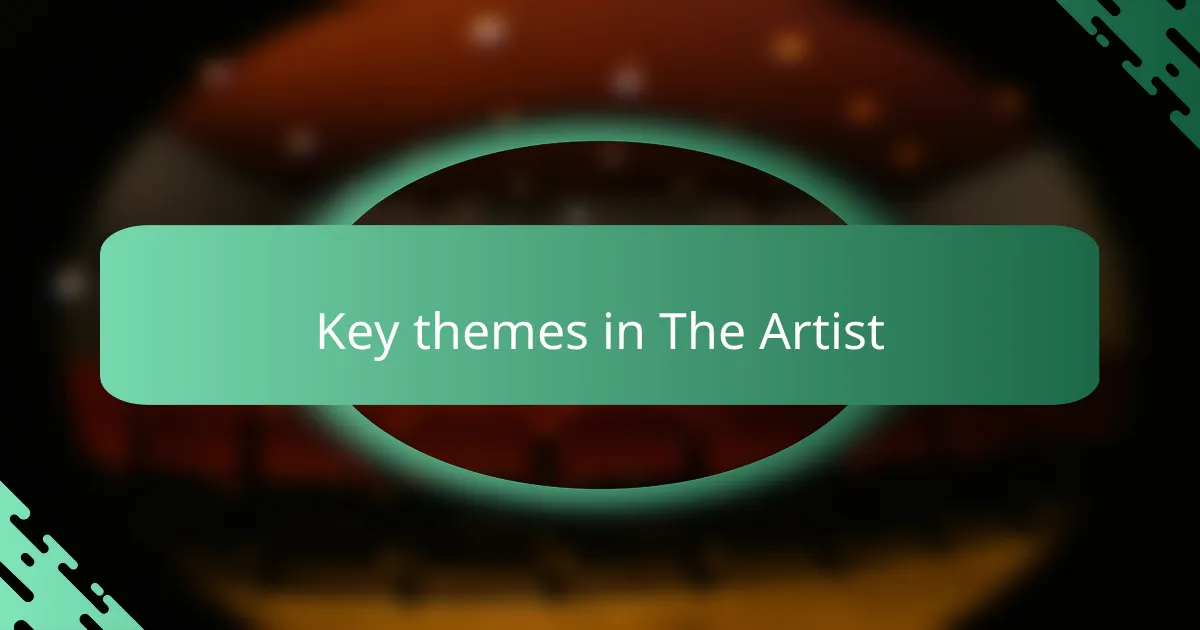
Key themes in The Artist
One of the most prominent themes in “The Artist” is the struggle between old and new Hollywood. I found it fascinating how the film captures the transition from silent cinema to the advent of sound, which deeply resonated with me as a lover of classic films. This theme reminds us of the inevitable changes in the industry and how they can create both excitement and fear for artists navigating these shifts.
Another key theme is the idea of love and loyalty amidst personal and professional challenges. Watching George Valentin and Peppy Miller’s relationship evolve, I couldn’t help but reflect on the sacrifices we sometimes make for our passions and loved ones. Their bond showcases the power of connection in a world that is ever-changing, and I’ve often found myself drawing parallels to my own life when grappling with the balance between ambition and personal relationships.
- The transition from silence to sound: Examining the impact on cinema and actors.
- Love and loyalty: How relationships can shape and endure through adversity.
- The nostalgia for a bygone era: A reflection on how art evolves amidst technological changes.
- Identity and reinvention: The characters’ journeys highlight the constant need for adaptation.
- The role of silence and sound: Exploring storytelling techniques and their emotional impact.
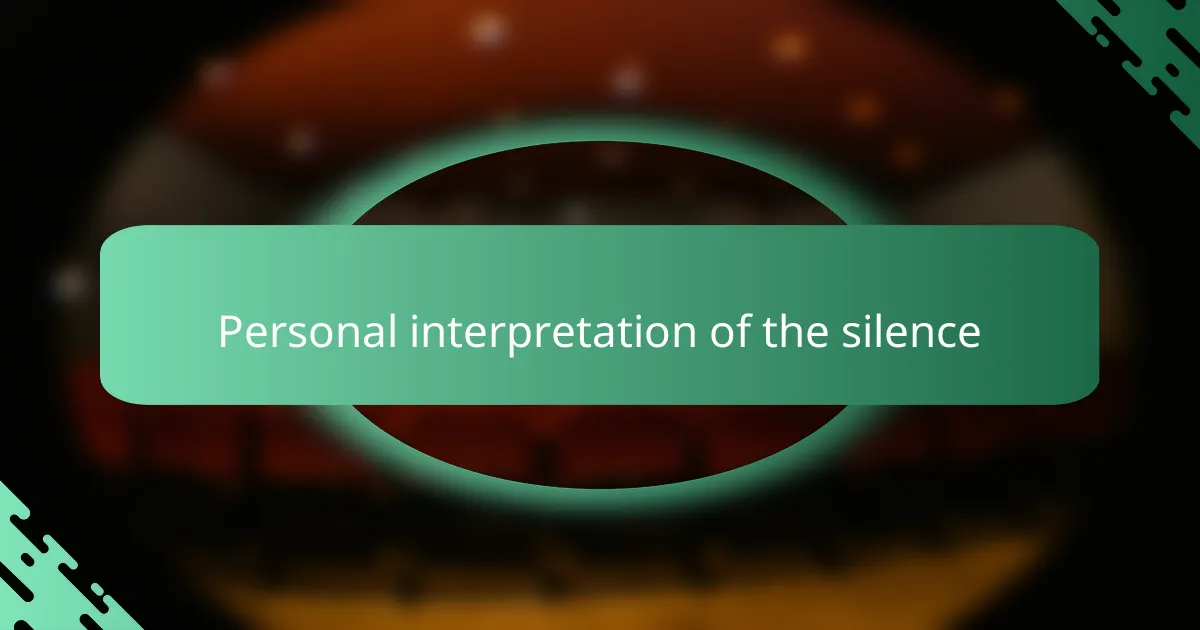
Personal interpretation of the silence
When I watched “The Artist,” I couldn’t help but feel that the silence spoke volumes. This film, celebrating the golden age of silent cinema, uses quiet moments to convey deep emotion and character development. I found myself reflecting on how silence can express longing and joy, creating a richer viewing experience. It reminded me of times when words failed me, yet emotions were laid bare through simple gestures.
The silence in the film also evokes nostalgia. Each quiet scene made me think of classic films that relied on visual storytelling. I remember my own experience watching a silent film festival; the lack of dialogue forced me to pay closer attention to the nuances of human expression, just as “The Artist” does so beautifully.
Here’s the comparison table highlighting significant aspects of silence in “The Artist”:
| Aspect | Interpretation |
|---|---|
| Emotional Depth | Silence enhances the protagonist’s internal struggles and triumphs. |
| Nostalgic Feel | Reflects the charm of classic cinema, transporting viewers to a different era. |
| Character Connection | Fosters a deeper bond between the audience and characters through non-verbal cues. |
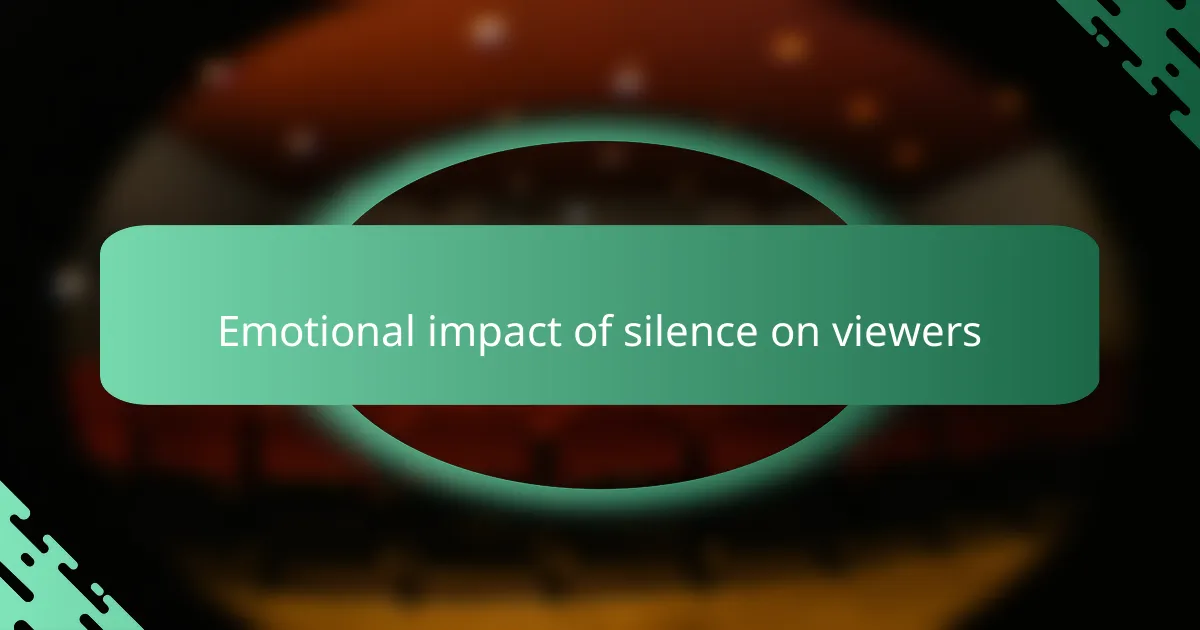
Emotional impact of silence on viewers
The emotional impact of silence in “The Artist” is profound and multifaceted. When I first watched the film, the absence of dialogue drew me in, creating an intimate space that allowed me to truly connect with the characters. I found myself feeling their joys and sorrows deeply because the silence forced me to pay closer attention to their expressions and body language.
In cinema, silence can evoke a range of emotions—from tension and anticipation to nostalgia and longing. I remember being struck by a particular scene where silence enveloped the protagonist, showcasing his internal struggles. This stillness became a canvas for my emotions, inviting me to reflect on my own experiences with silence in life.
The table below contrasts the emotional responses that silence can elicit compared to dialogue-driven scenes:
| Aspect | Emotional Impact |
|---|---|
| Silence | Introspection, deep connection, heightened tension |
| Dialogue | Exposition, clarity, immediate understanding |
